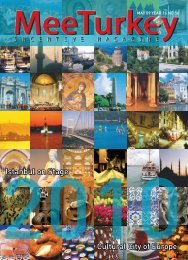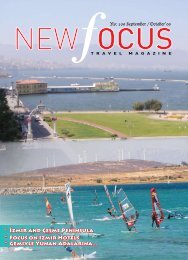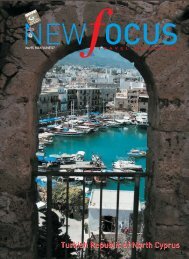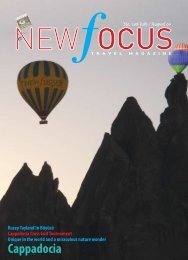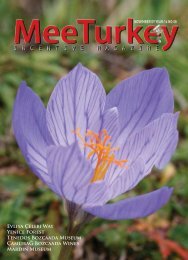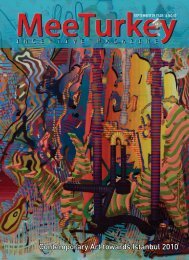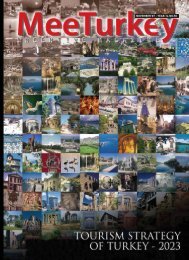TBy - S&M Publication ltd
TBy - S&M Publication ltd
TBy - S&M Publication ltd
You also want an ePaper? Increase the reach of your titles
YUMPU automatically turns print PDFs into web optimized ePapers that Google loves.
COVER STORY INCENTIVE MAGAZINE<br />
Gonul Paksoy From Collection to Creation<br />
G<br />
onul Paksoy, our cover story, will present three exhibitions to the<br />
world of Creation and Art.<br />
The first Exhibition will take place at the Kadir Has University<br />
"Rezan Has Museum" at Halic (Golden Horn).<br />
"From Collection to Creation - Gonul Paksoy"<br />
The exhibition will be opened on the 19th April for two weeks.<br />
It will be within the International Congress of Textiles and Carpets, ICOC.<br />
The second exhibition will again be at the Has University to celebrate the<br />
10th anniversary of the University.<br />
"Soil shaped by Culture" archeological collection of pottery - Gonul Paksoy<br />
The exhibition will open on the 8th May and will be for four months.<br />
The third Exhibition took place at Kuwait between March 3-8 2007 and it was<br />
on the aerations of Gonul Paksoy.<br />
"Timeless Purity" (minimalism) was the name of the exhibition.<br />
Alongside the new textiles you use in the garments you create, you also use<br />
quite precious and very original old fabrics. You treat each one in a special<br />
manner and sometimes you dye them. What is your reason for using and<br />
dyeing old fabrics? Why do you feel the need to do this?<br />
The reason why I dye fabrics anew is in part to be able to play with their texture<br />
and in part because I do not like their color. By playing with their texture<br />
and color, I obtain a totally different fabric. I transform the colors into<br />
mine. Dyeing old fabrics, especially Ottoman textiles, can have some incredibly<br />
beautiful results. Many of these fabrics had once been used in the imperial<br />
palace or in places having to do with the court. The best craftsmen were<br />
employed to weave them, the best threads, the best dyes, the best silver<br />
threads were used to produce them. I must say that, the fabrics woven in<br />
Istanbul, Edirne and Hereke hold a special place in my eyes.<br />
38 [[<br />
APRIL’07<br />
Isn't it risky to use this kind of material?<br />
Textile products need to be preserved with great care. You need to have special<br />
conditions to reduce their rapid deterioration. This is something only<br />
certain museums are able to achieve. When I purchase certain fragments, I<br />
see that they have been preserved with care by their previous owners<br />
between several sheets of paper. This gives fabric more endurance.<br />
Whereas there are others who , even if they keep something because they<br />
think it is of value, they can cause it harm by keeping it in inappropriate conditions<br />
or without special care. And such fabrics demand much more attention<br />
when they are cleaned, washed and dyed. There are some valuable<br />
pieces amongst the old fabrics I have bought and some of them are in pretty<br />
poor state. Indeed, this is a form of risk taking. I succeed in recycling<br />
such a fragment then I win, and my gain is a fantastic piece, but if I don't,<br />
then I accept losing the money and effort I spent on it. At times, a piece of<br />
fabric that looks sturdy may begin to tear once you start detaching it. You<br />
need to be very attentive and act with care in this job. From time to time people<br />
ask me whether I do not feel uneasy when I modify a kaftan. No, I don't.<br />
I protect everything that needs protection. This is why I have a lovely collection<br />
of textiles. If one day a textile museum is founded in Turkey, or if I can<br />
set up a museum myself, I shall exhibit all of them. If a big museum is founded<br />
and I can have confidence in their management, I may even donate my<br />
acquisitions. I do not destroy things, I believe that I re-infuse life into those<br />
things that have been abandoned and are about to disappear. I add them my<br />
energy and incorporate a tremendous amount of love and effort in them. I<br />
endow them with an artistic identity. The women who have bought Gonul<br />
Paksoy garments become addicted to them and they become an inseparable<br />
part of their lives.




